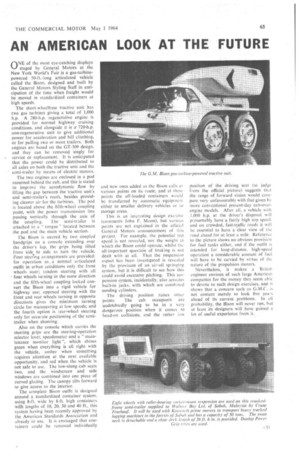AN AMERICAN LOOK AT THE FUTURE
Page 67

If you've noticed an error in this article please click here to report it so we can fix it.
ONE of the most eye-catching displays staged by General Motors at the New York World's Fair is a gas-turbinepowered 50-ft.-long articulated vehicle called the Bison, designed and built by the General Motors Styling Staff in anticipation of the time when freight would be moved in standardized containers at high speeds.
The short-wheelbase tractive unit has two gas turbines giving a total of 1,000 h.p. A 280-h.p. regenerative engine isprovided for normal highway cruising conditions, and alongside it is a 720-h.p. non-regenerative unit to give additional power for acceleration and hill climbing, or for pulling two or more trailers. Both engines are based on the GT-309 design. and they can be removed singly for service or replacement. It is anticipated that the power could be distributed to all axles on both the tractive unit and the semi-trailer by means of electric motors.
The two engines are enclosed in a pod mounted behind the cab, and this is stated to improve the aerodynamic flow by filling the gap between the tractive unit's and semi-trailer's roofs, besides providing cleaner air for the turbines. The pod is located above the fifth-wheel coupling point, with the power transmission line passing vertically through the axis of the coupling. The semi-trailer is attached to a " tongue " located between the pod and the main vehicle section.
The Bison is steered by two coupled handgrips on a console extending over the driver's lap, the grips being tilted from side to side to turn the vehicle. Four steering arrangements are provided: for operation as a normal articulated outfit in urban conditions only the front wheels steer; tandem steering with all four wheels turning in the same direction and the fifth-wheel coupling locked convert the Bison into a rigid vehicle for highway use; opposed steering with the front and rear wheels turning in opposite directions gives the minimum turning circle for manceuvring at low speeds; and the fourth option is rear-wheel steering only for accurate positioning of the semitrailer when shunting.
Also on the console which carries the steering grips are the steering-operation selector lever, speedometer and a " maintenance monitor light", which shines green when everything is all right with the vehicle, amber when something requires attention at the next available opportunity, and red when the vehicle is not safe to use. The low-slung cab seats two, and the windscreen and side windows are combined into one piece of curved glazing. The canopy tilts forward to give access to the interior.
The complete Bison outfit is designed around a standardized container system, using 8-ft. wide by 8-ft. high containers with lengths of 10, 20, 30 and 40 ft., this system having been recently approved by the American Standards Association and already in use. It is envisaged that containers could be removed individually and new ones added as the Bison calls at various points on its route, and at these points the off-loaded containers would be transferred by automatic equipment either to smaller delivery vehicles or to storage areas.
This is an interesting design exercise (comments John F. Moon), but various points are not explained in the official General Motors announcement of this project. For example, the potential top speed is not revealed, Dor the weight at which the Bison could operate, whilst the all-important question of braking is not dealt with at all. • That the suspension aspect has been investigated is revealed by the provision of an air-oil springing system, hut it is difficult to see how this could avoid excessive pitching.. This suspension system, incidentally, also actuates built-in jacks. with which are combined sanding cylinders..
The driving position raises other points, The cab occupants are undotibtedly going to be in a very .dangerous • position when it comes to head-on collisions, and the rather low position of -the driving scat (to judge: from the official picture) suggests that the range of forward vision would compare very unfavourably with that given by More conventional present-day cab-overengine models. After all, a vehicle with 1,000 h.p. at the driver's disposal will presumably have a fairly high top speed. and on crowded, fast-traffic roads it will be essential to have a 'clear view of the road ahead for at least a mile. Reference to the picture shows no obvious provision for fuel tanks either, and if the outfit is intended for long-distance, high-speed operation a considerable amount of fuel will have to be carried by virtue of the nature of the propulsion motors.
Nevertheless, it makes a British engineer envious of such large American companies for the money they seem able to devote to such design exercises, and it shows that a concern such as G.M.C. is not content merely to look five years ahead of its current problems. In all probability, the Bison will never run, but at least its designers will have gained a lot of useful experience from it.




















































































































































































































































